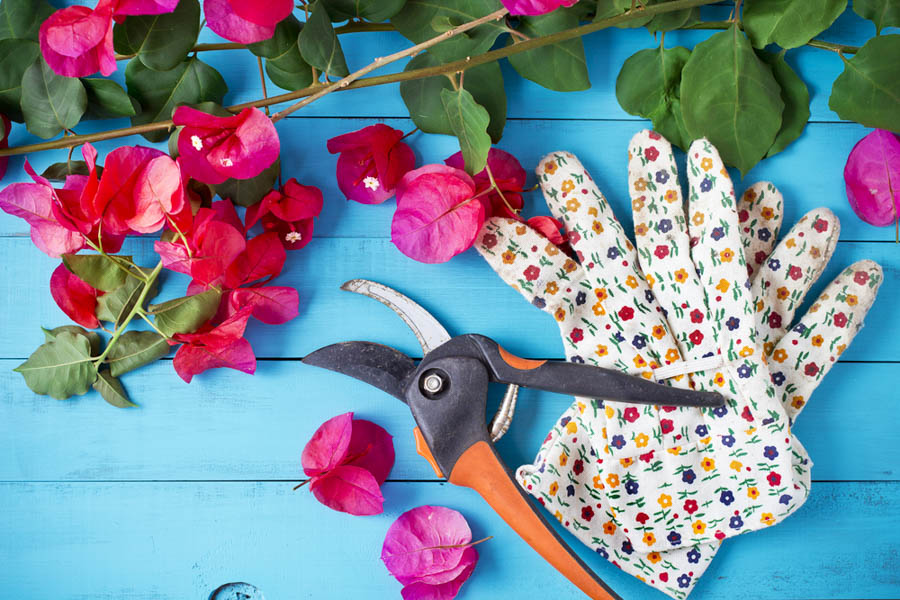Bougainvilleas: Essential Pruning and Maintenance

GardenZeus receives commissions for purchases made through links in this post. There is no additional cost to you.
by Ann Clary with C. Darren Butler
What makes bougainvilleas so appealing to gardeners around the world? Undoubtedly the profusion of colorful and long-lasting flower bracts, the specialized leaves that are often mistaken for blooms or petals. In Mediterranean and mild-winter California areas, bougainvillea are a signature landscape plant, offering their profuse displays in a range of colors including pink, purple, magenta, white, yellow, orange, and red. The true flowers are small and inconspicuous, white or cream colored, and nestled within the colorful bracts. Bougainvilleas are much loved for their exuberant and lasting display of summer color at a time when many other plants are suffering in the Southern California summer heat.
Pruning. Bougainvilleas produce their flower bracts or “bloom” on new growth. Frequent or at least annual pruning is important to encourage new growth that will produce the colorful bracts. Overgrown, neglected, enormous, thorny bougainvillea shrubs are a candidate for the worst-ever pruning nightmare. Older bougainvilleas tend become dense as dead leaves, spent bracts, old twigs, and other plant matter accumulates to form thatch within their twiggy interiors. Neglected bougainvillea may produce unwanted conditions such as taking up too much space, becoming difficult to manage and prune, becoming too large or heavy for supports, providing an almost-unassailable home for rodents, and losing their colorful and attractive appearance. The dense inner woody twigs and branches take up space and lack aesthetic value—and they don’t produce the lovely bracts.
It is particularly important to prune bougainvillea regularly to maintain reasonable branch structure, keep them manageable, and avoid tall, heavy, and/or unruly shrubs that put out little new growth each year and bloom only occasionally or minimally. Bougainvillea naturally produce many main stems that can become a tangle within just a few years. Vines can be pruned at almost any time of year except during periods of hot weather or frost.
Don’t hesitate to cut back larger, older stems as needed for good structure, or to provide a hard structural pruning every few years. Frost-free periods from winter through early spring when plants aren’t actively blooming are ideal for major pruning. Reasonably skilled structural pruning is important for bougainvillea. Hire a professional or take the time to learn proper structural pruning.
Simple pruning involves removing snipping here and there for shaping, cutting back generally to encourage new growth, and removing unwanted stems to encourage whatever permanent form is desired. To train your plant into an espalier or to direct it to grow and bloom in a specific location, attach selected larger branches to support and remove the smaller branches growing in the wrong direction. If you want your bougainvillea to grow on a fence, weave small and young branches throughout the links or open spaces. Remove or redirect uncooperative branches.
Bougainvilleas are one of those plants that benefit from frequent or almost constant cleanup and light pruning to keep them manageable and maintain their shape, including pinching back, light trimming, training, and cleaning up dead leaves and stems. Pinching or snipping off the tips of new shoots is an easy way to shape smaller plants to be more full and bushy, and is especially recommended for shrubby cultivars.
Bougainvilleas naturally follow a cycle of blooming followed by a rest period. Healthy plants that aren’t overwatered repeat this cycle during the warmer and drier parts of the year. Dedicated cleanup and moderate pruning is recommended during the rest period after every bloom cycle. Monitor or notice blooming to time your pruning during the rest period that follows.
Beware of maintenance gardeners who use hedge trimmers on bougainvilleas unless you want square or round shrubs and hedges! This practice may regularly remove the new growth needed to produce the colorful bracts, produce unattractive views of sheared stems, and tend to maintain bougainvilleas as nonblooming and nondescript green/brown shrubs.
Remember that pruning bougainvilleas can be a dangerous task: they have thorns! Gardeners should tackle bougainvillea pruning with a pair of pruners, loppers, heavy gloves, hat, eye protection, long sleeves and long pants.
Soil Amendments. Bougainvillea bloom best during warm weather after several weeks with little or no water and fertilizer, followed by generous watering and fertilizing. Allow dry periods, then fertilize with organic manures, compost, and/or a balanced fertilizer for blooming perennials while also increasing water. Bougainvillea plants will often perform well throughout summer and into fall if fertilized once in late winter or early spring.
GardenZeus has customized gardening information by plant and zip code. To get started, enter your zip code here.
Other articles of interest include:
Bougainvillea: An Ideal Plant for Hot Mediterranean Areas
Constructing a Mediterranean Herb Garden


